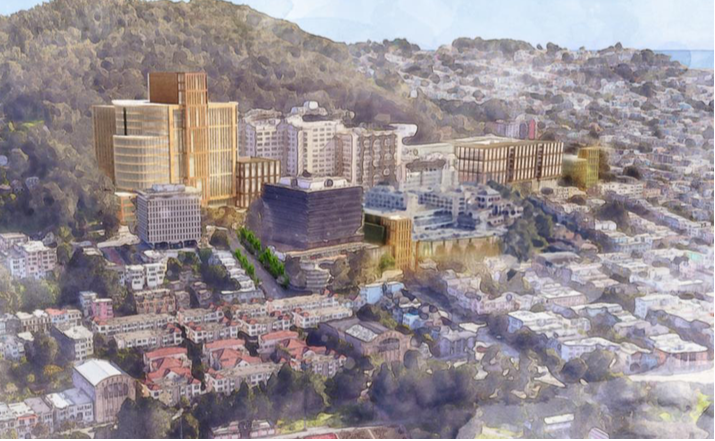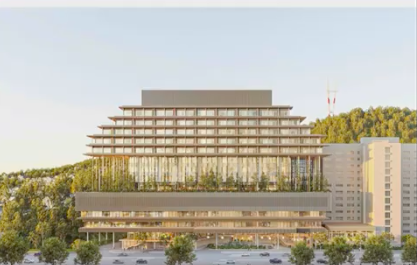The UC Board of Regents voted unanimously today to approve the next steps in the massive Parnassus Heights campus expansion, despite significant misinformation and some sharp critiques of the project’s management.

But in a key move, the board said that approval was contingent on the Regents chair signing a Memorandum of Understanding with the city and that the university must comply with that MOU.
That means the development of a new hospital, research and office space, and housing has gone a step further – but there is still a long way to go before the project is final.

UCSF has already broken a deal approved by the Regents in 1976 that limited the amount of total space on the campus. The school has offered the city a Memorandum of Understanding that the city attorney says can’t be enforced in a court of law.
However, the vote today essentially puts the board on record saying that UCSF will comply with the MOU and puts Board Chair John Perez, who had some serious criticisms of the project, in the position to influence the final direction.
“The Regents, led by Chair John Perez and Vice Chair Cecilia Estolano, clearly shared the concerns we raised around UCSF’s proposed agreement with the city, an MOU that is intended to provide community benefits to offset the impacts of the development,” said Sup. Dean Preston, who represents D5, which will be heavily impacted by the project.
In a meeting of the Regents Finance and Capital Strategies Committee Wednesday, Chancellor Sam Hawgood took a decidedly hostile tone toward community activists, saying that his office had received a considerable volume of communication in the past week but “none of this involves any new environmental information or requires any new analysis.”
Then he said that Sup. Myrna Melgar, whose District 7 includes much of the project area, “just sent a letter of support for the project.”
Help us save local journalism!
Every tax-deductible donation helps us grow to cover the issues that mean the most to our community. Become a 48 Hills Hero and support the only daily progressive news source in the Bay Area.
Melgar had voted with a 10-1 majority on the Board of Supes to seek a delay in the Regents approval.
I talked to Melgar, and she sent me the letter. She did, indeed, say she supports the project, in general, and that it’s critical to have a hospital that serves the West side of town. (Almost nobody disagrees with that.)
In her letter, though, she said that the MOU needed to be more specific about affordable housing, particularly for lower-paid workers. And she told me that she demanded a project-labor agreement that would guarantee union jobs.
“They told me they had never signed a project-labor agreement before,” Melgar said. She said she had seen “a lot of progress in that direction” but that the deal wasn’t final.
So Hawgood wasn’t exactly clear on that point.
Nor was he clear on the height of the new building. He told the committee that the current building is 14 stories and the new one – according to the latest architectural plans – would be only 15 stories (although earlier discussions mentioned at many as 30 stories).
But Perez pushed back. “But the overall height will be taller than the existing hospital,” he said. In fact, Hawgood admitted, with taller floors and a mechanical structure on top, the new proposal would be 280 feet high.
The current building is 200 feet high.
“That is 40 percent taller than the current building,” Perez said. “I love the idea, but I have to live with myself that we are being transparent with people. The opacity between stories and height gives me pause.”
Perez cited the board’s 10-1 vote and said repeatedly that he was worried UCSF was not acting in good faith and had damaged its relations with the community.
Hawgood also said that the plan was supported “by the affordable housing community” in San Francisco.
That struck Peter Cohen, co-director of the Council of Community Housing Organizations – the leading voice for affordable housing in the city – as a bit odd.
CCHO just voted to demand that UCSF build more deeply affordable housing, front-loaded so that it’s in place before all the new workers arrive.
The current plans would allow the school to delay much of the housing for more than a decade.
“I have no idea who UCSF is claiming to represent the ‘affordable housing community,” he said. “There are so many phonies out there today.”
Regent Janet Reilly made a point of challenging Hawgood on the future of the historic murals in a building that is set to be demolished. Nothing in the project Environmental Impact Report mandates that the murals be saved.
Hawgood promised that UCSF would do everything possible to preserve the murals and make them available at some point for public display.
The huge elephant in the room that nobody on the Board of Regents even mentioned is the vast problem with the jobs-housing balance. The new project will create far, far more jobs than housing at any level; when you add in the new students, the pressure on the surrounding neighborhood will be intense.
Of course, we have no idea what will happen to housing prices and availability post COVID, but if a half-century of history is any guide, the Haight, the Inner Sunset, and the other areas around Parnassus Heights will see higher prices, more demand, and potentially more displacement.
All Hawgood said was that there was no way that UCSF would build enough housing to cover the new demand it was creating.
In the end, the Regents voted to certify the EIR and approve the policy changes that would move this to the next step. But this is by no means a finished deal: The hospital building itself will need an EIR, and Perez will have to sign off on the MOU, and it’s entirely possible that there will be litigation.
“The chancellor may think this is the end,” Melgar told me. “But it’s not even close.”




